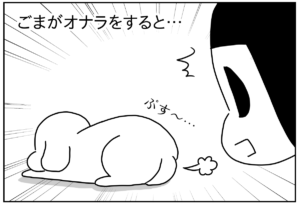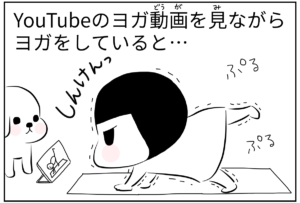Let’s learn Japanese with our funny and laid-back manga blog (yonkoma manga), “Caffeine Tolerance”.
CONTENTS
Manga Blog (Japanese Version)

Vocabulary & Grammar
- 耐性 – tolerance
- ある夜 – one night
- 飲んでいた – was drinking
- 一口 – one sip, one bite
- ちょっと – a little bit
- ちょうだい – give me
- ズズッ – onomatopoeia for sipping
- たくさん – a lot
- 忠告する – to warn
- あんまり + verb dictionary-form + と – if you do … excessively
- 今夜 – tonight
- 眠れなくなる – won’t be able to sleep
- ズズーッ – onomatopoeia for slurping
- 秒で (slang) – in a second
- バケモノ – monster
- ギンッ – onomatopoeia for being wakeful, red eyes
Manga Blog (English Version)

Comment from the Author
ベトナムアイスコーヒーはカフェインが多く入っているので、気をつけましょう(お茶以外の人は)。
Vietnamese Iced Coffee has a lot of caffeine so please be careful (except for Ocha).
RELATED LINKS
Support Easy Peasy Japanesey
If you enjoy our content, please consider supporting Easy Peasy Japanesey. Your support will help keep us going. Thank you for your support!



How about showing the vocabulary before the English version? Otherwise when I don’t know a word in the Japanese version I’m having to scroll past the English version to get to vocabulary.
Thanks for your comment! We have received the similar request before so we added printing buttons so that you can print it out and check the vocabulary on the sheet. But we will consider changing the position of the vocabulary as well. Thanks again for your feedback!
Every week I look forward to the next entertaining little story from you Anzu. One thing I have noticed a few of times in different blogs (I can’t find the other examples) is words such as バケモノ / 化け物 which seem to be Japanese words written in Katakana. Is there a reason, or is that just how it is?
Good question, Chris-san!
There are various reasons when we write Japanese words in Katakana, but in this case, it’s to soften or lighten the impression that the Kanji word has.
化け物 in Kanji shows the literal meaning “things transformed” which gives you a creepy and serious impression, but Katakana makes it look more casual. I used バケモノ in my manga so that it looks more comical and funnier than 化け物. In other words, on proper books or blogs which takes monsters seriously, they would use 化け物.
For another good example, loan companies use ローン instead of 借金 in their ads to make people think it’s something easy and casual to try.
Hope it’s clear!
How very interesting! And thank you for taking the time to give such a wonderfully clear explanation Anzu-san. I did find the other words after I sent the question (ゴミ、イス、カバン).
For those words, there are different reasons. ゴミ and カバン are written in Katakana as their kanji (塵 and 鞄) are not included in the joyo kanji list.
In this blog post, I explain why ゴミ is written in Katakana:
https://epjapanesey.com/muskas-quote-look-the-people-are-like-rubbish/
As for イス (椅子), the kanji “椅” was registered in the joyo kanji list in 2010 but until then, we’ve been using イス for a long time so it’s still written in Katakana even though it’s in the joyo kanji list.
Thank you again! And so interesting again! And the link you gave has already answered the question which immediately sprang to mind … “Why not hiragana?”.